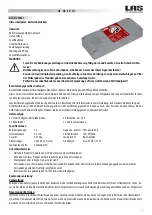
SBS System – SB-1000 Operation
15
Manual Balance Mode
Setup Manual Mode
In Manual Balance mode three additional settings are added under the
Setup menu. These new settings
are listed first in the menu. Each press of the
Setup button will present each of these settings in the
following sequence.
These settings are followed in the Setup menu by the four settings already described under Setup Automatic
mode (Limit, Tolerance, Critical Vibration, Critical RPM).
Balance Type. Each type describes the method of balancing
weight attachment to be used on the machine to perform
balancing.
Single Weight – One single weight of variable mass is
positioned at a variable angle position.
Two Weights – Two equal fixed mass weights are
positioned at variable angle positions.
Three Weights – Three equal fixed mass weights are
positioned at variable angle positions.
Fixed Positions – A specified number of mounting positions
in an equally spaced fixed pattern (such as a bolt circle) are
available for adding variable mass weights.
If Fixed Positions is selected, then the following screen is
displayed and allows for editing the number of fixed positions
from 3 to 99. The positions are assumed to be evenly spaced in a
360 degree pattern. They must be labeled on the machine from 1
to the highest number available, in order to identify the positions
during balancing.
Scale Direction.
Sets the direction of the scale used to position
the balance weights relative to the wheel’s direction of rotation.
The weight scale direction is the direction (clockwise or
counterclockwise when facing the scale) in which the angle
references (0°, 90°, 180° etc.) or the weight position location
numbers (1,2,3,4, etc.) increase. The system must know if this
direction is the same as, or opposite to, the wheel’s direction of
rotation.
The
top image shows the selection where the weight scale and
spindle rotation are in the same direction
.
The bottom image shows
the selection where the weight scale and
spindle rotation are in the opposite direction
.
















































